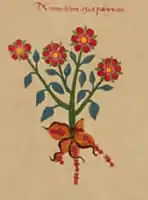Nonochton
Nonochton is the Classical Nahuatl name for a plant whose identity is uncertain. Suggested plants include Portulaca, Pereskiopsis,[1] and Lycianthes mociniana, a plant now called tlanochtle in the local variety of modern Nahuatl spoken by highland farmers that cultivate it for its fruit.[2]

Illustration of nonochton from the Libellus de Medicinalibus Indorum Herbis (1552).
Medicinal uses
In Aztec medicine, nonochton was used as an ingredient in a remedy for pain at the heart:
For him whose heart pains him or burns, take the plant nonochton that grows near an ants’ nest, gold, electrum, teo-xihuitl, chichiltic tapachtli and tetlahuitl, with the burned heart of a deer, and grind them up together in water; let him drink the liquor.
See also
- Aztec entheogenic complex
References
- Nicholson, Rob (1999). "Az-Tech medicine". Natural History. 108 (10): 54–59.
- Lindsay, Robert (April 23, 1994). "Aztec fruit reappears in the mountains of Mexico". New Scientist. pp. 66–67.
- Gates, William (2000) [1939]. An Aztec Herbal: The Classic Codex of 1552. Dover. p. 47. ISBN 0-486-41130-3.
This article is issued from Wikipedia. The text is licensed under Creative Commons - Attribution - Sharealike. Additional terms may apply for the media files.